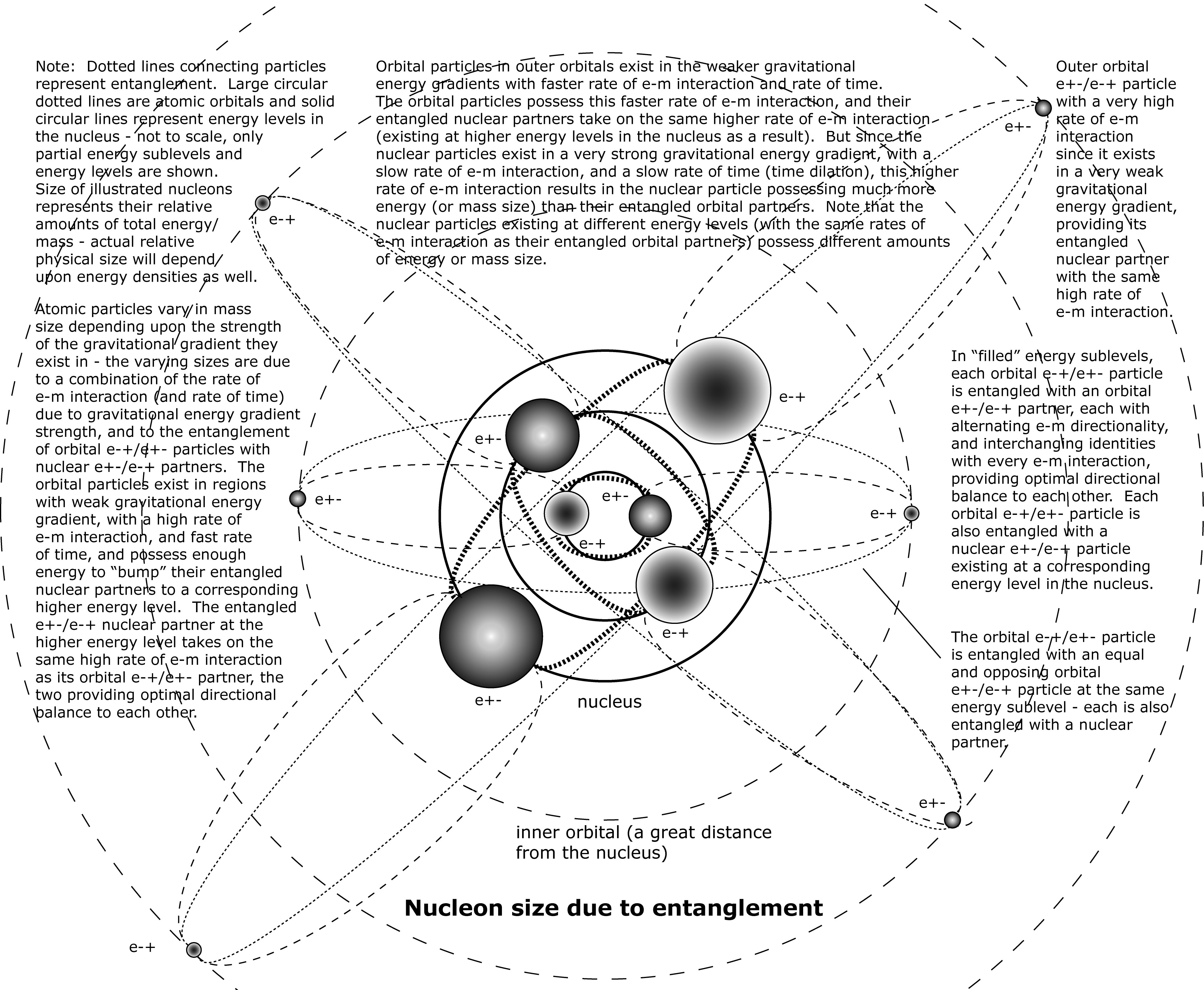 Each orbital e-+/e+- particle (Note: e-+/e+- designates that the elementary particle is alternating between [-] and [+] e-m directionality with every e-m interaction) is entangled with an e+-/e-+ nuclear particle, each with alternating opposing e-m directionality. The orbital particle exists at a significant distance from the atomic nucleus within a region of significantly weaker gravitational energy gradient – with a faster rate of e-m interaction and correspondingly faster rate of time.
Each orbital e-+/e+- particle (Note: e-+/e+- designates that the elementary particle is alternating between [-] and [+] e-m directionality with every e-m interaction) is entangled with an e+-/e-+ nuclear particle, each with alternating opposing e-m directionality. The orbital particle exists at a significant distance from the atomic nucleus within a region of significantly weaker gravitational energy gradient – with a faster rate of e-m interaction and correspondingly faster rate of time.
When both entangled partners have the same rate of e-m interaction (1:1), they compose a system with optimum directional balance, or lowest possible energy level. As a result, the nuclear particle takes on the same high rate of e-m interaction as its entangled orbital partner – from the instant of creation inside a star.
Because there is an extremely strong gravitational gradient within the atomic nucleus, the rate of e-m interaction, or rate of time, is much slower than that of its orbital particles that exist in a relatively weak gravitational energy gradient. So when the nuclear particles possess the same high rate of e-m interaction (and correspondingly faster rate of time) as their entangled orbital partners, they possess much more energy (or mass) than their entangled orbital partners because they exist in a region of strong gravitational gradient (slower rate of time or e-m interaction) while having the much higher rate of e-m interaction of a significantly weaker gravitational energy gradient.
In other words, particles in a nucleus are much larger than their orbital partners due to their entangled relationships and their strong gravitational gradient. In this model, there is no need for neutrons existing in the atomic nucleus (although neutrons can be produced in a high energy nuclear environment). Instead, all particles in the nucleus alternate e-m directionality with each e-m interaction, in the opposing direction of their entangled partners. Each nuclear particle and its entangled orbital partner oscillate back and forth between a positive [+] and a negative [-] charge, providing directional balance to each other. However, due the entangled relationship, there is no net e-m directionality, or charge. In this model, all atoms are compound bosons with the exception of ions. Keep in mind that atoms are formed within the core and other regions of a star. The high pressures and temperatures govern the formation of the atom.
The energy levels within the nucleus correspond to those of the orbital energy levels. However, within the very strong gravitational gradient of the nucleus, it takes significant energy for a nucleon to jump from a lower energy level to a higher one. As in the case of orbital particles, nucleons may only occupy specific energy levels.
It may be that the nucleons themselves may only exist at multiples of the mass-energy of a proton. So nucleons may exist at 1 X proton mass, 2 X proton mass, or 3 X proton mass. It is less probably that a nucleon would exist at 4 X proton mass, and this will be discussed on a future website.
The orbital particle cannot take on the slower e-m interaction or rate of time of its nuclear partner because energy moves toward its lowest possible energy level – and energy within a strong gravitational energy gradient is analogous to higher pressure even though energy appears to become lazier within a strong gravitational gradient due to the slower rate of time (or slower rate of e-m interaction). However, mass is essentially kinetic energy that is trapped and confined as potential energy by strong gravitational energy gradients. This confined and compressed energy wants to move outward toward regions of weaker gravitational gradient analogous to lower pressure and a lower energy level. It simply needs a trigger to release its enormous energy. The bottom line is that an orbital e-+ particle existing in a region of weaker gravitational energy with lower ‘pressure’ is not going to move inward toward a region of stronger gravitational energy with higher ‘pressure.’
However, as long as entanglement exists between the nucleons and the orbital particles, the atomic nucleus will remain stable. Each nucleon is entangled with one other nucleon and one orbital partner at a corresponding energy level. And each orbital particle is entangled with one other orbital particle and with one nucleon partner at a corresponding energy level. Identical entangled particles within a given energy level may act as one energy entity …. as bosons.
